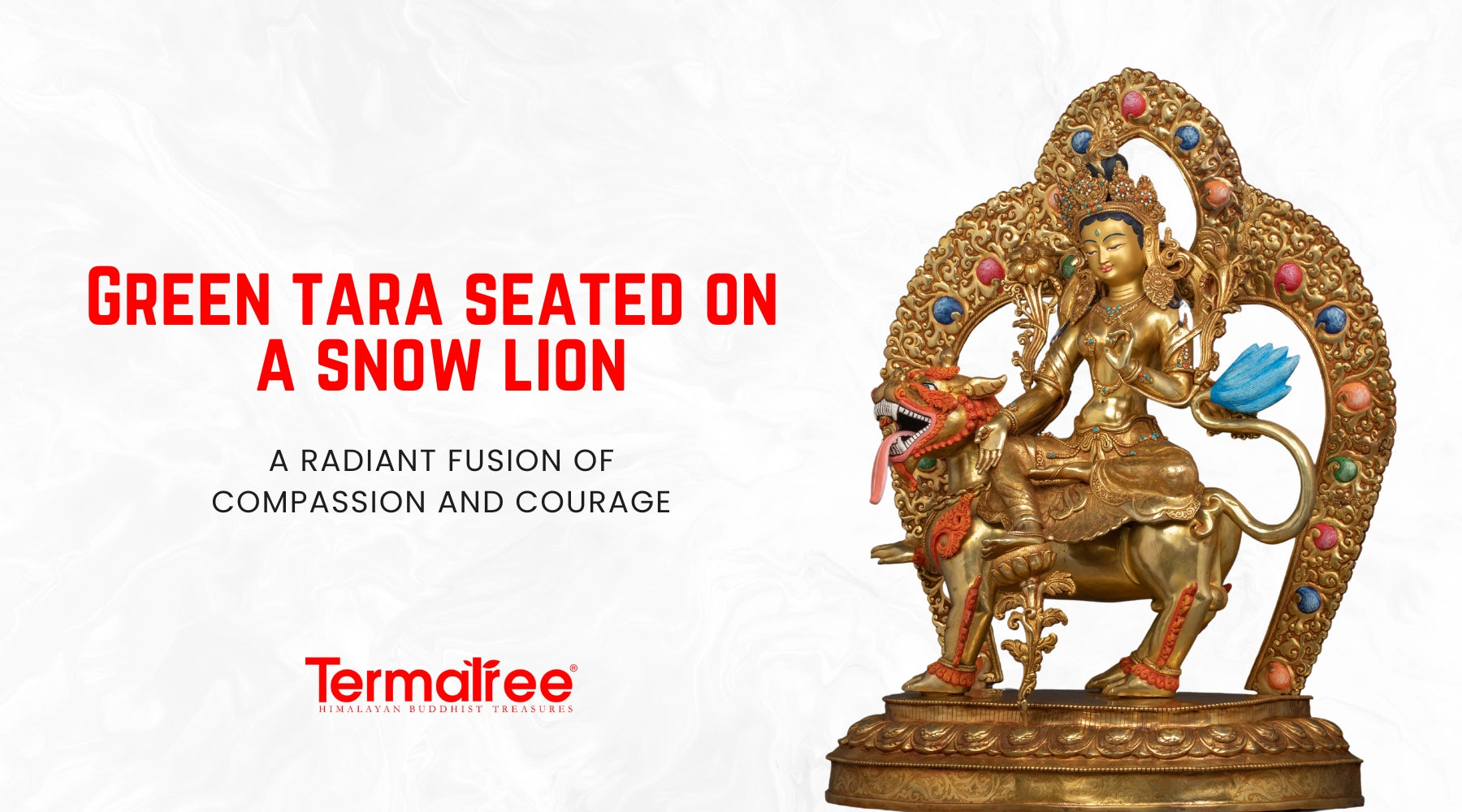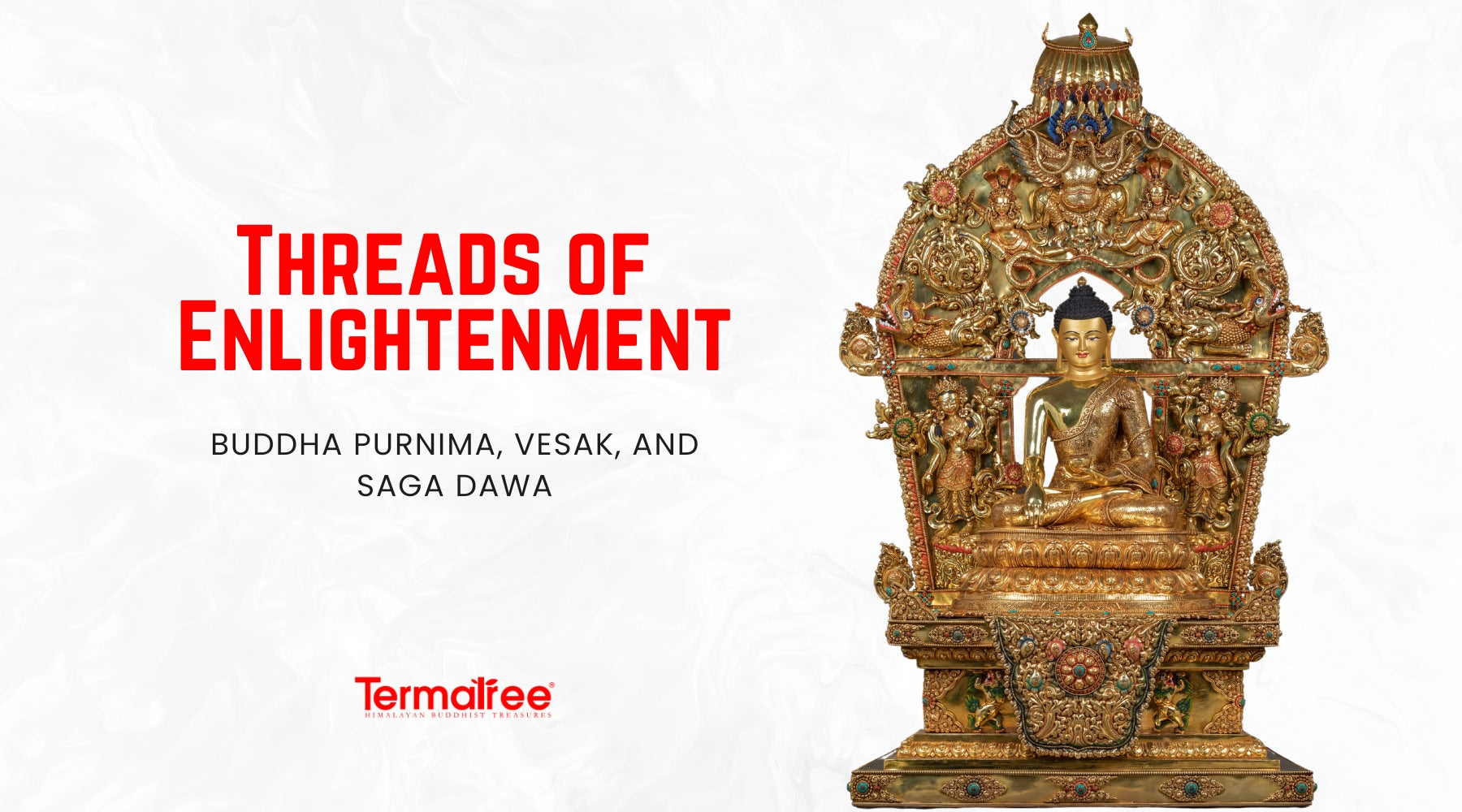Who was Mahapajati Gotami?
Historically, Mahaprajapati Gotami was the Shakyamuni Buddha’s maternal aunt and also his foster mother, who became the first-ever Bhikkhuni (fully ordained nun) of the Buddhist Monastic Community. Her ordination was not only the fulfillment of her personal vow but also a turning point in the spiritual history of countless women who would follow her path.
Mahapajapati and Queen Mayadevi ( the birth mother of Buddha Shakyamuni) were sisters of a Sakyan royal family. This blog will further discuss in detail how Pajapati Gotami later became the founding member of the Nun's Monastic Order.  Picture credit: Wikimedia Commons
Picture credit: Wikimedia Commons
Mahapajapati Gotami’s Previous Live as Mentioned in Jataka Tales:
Before her final birth as the first woman to be ordained by Shakyamuni Buddha, Mahapajapati Gotami had accumulated great merit and spiritual aspiration from many lifetimes. In three notable past lives, her karmic resolve to support the Dharma and follow the path of liberation began to take root.
In one of her lifetime, she was born into a worthy family in the city of Hamsavati during the time
of Padumutara Buddha. On one event of listening to a discourse taught by the
Buddha, she happened to see a female monk (bhikkhuni) who was honored as the foremost among the bhikkhunis who were enlightened earliest.
The Pali word ‘Rattannu puggala’ means the one who was enlightened earliest.
This also means the senior most in the Monastic order to understand the Four Noble Truths earliest. So, she aspired to become the same female monk in her future existence. She made extraordinary offerings to the Buddha and expressed her wish to become the foremost Bhikkhuni to Buddha. Hence, Buddha predicted that her aspiration would be fulfilled. Her unwavering prayers for female ordination—though unrealized in those times—continued to gain karmic momentum, leading to her final and most significant rebirth.
The Last Birth and the Great Renunciation of Gotami:
On her final rebirth, she was reborn into the Sakyan royal family as the younger daughter of King Mahasuppabuddha in Devadaha. She was called Gotami and was the younger sister of Princess Mahamaya (Mayadevi). A prophecy was made by the court astrologers after scrutinizing the distinctive bodily features of the two sisters that the sons born of the two sisters would become a Universal Monarch.
When the two sisters came of age they were betrothed to King Suddhodana and were taken to Kapilvastu where Princess Mahamaya was made the Chief Queen. After Queen Mahamaya had given birth to Prince Siddhartha Gautam, three days later, Queen Mahapajapati Gotami also gave birth to a son, Prince Nanda.
When Prince Siddartha was only 7 days old, unfortunately, his mother Mahamaya died and Gotami took care of him as a foster mother. She nursed him leaving her own
son Nanda to be nurtured by nurses. With unwavering care, she dedicated herself fully to raising her young nephew, the future Buddha Shakyamuni.

Picture Credit: Sravasti Abbey
After Prince Siddartha Became Shakyamuni Buddha
When Crown Prince Siddartha renounced the world and attained Enlightenment, he became well known all over as Buddha, The Awakened One. He made his first visit to Kapilavastu, his birthplace after his liberation. On the next day of his arrival, he went into the city to collect alms. His father King Suddhodana listened to the Buddha’s discourse while still on his alms-round and attained Stream-Entry knowledge (Sotapanna). Later on, Prince Nanda was admitted into the Order and, on the 7th day, his biological son, Rahula was admitted as a novice to his monastic Sangha.
 View our Collection of Shakyamuni Buddha Statue
View our Collection of Shakyamuni Buddha Statue
How Pajapati Gotami Appealed Buddha for the Monastic Ordain?
After King Suddhodana had already attained Arhatship under the regal white umbrella at the court of Kapilvastu, he passed away the same day. Then, Queen Mahapajapati Gotami was keen to renounce the world and become a Bhikkhuni, female Buddhist Order. She approached the Buddha and requested ordination three times. But every time, she was turned down. Sometime later, having her head shaved and donned monastic robes, together with five hundred other sakyan women, she again approached Buddha with the request, but was again turned down.
She again repeated her request for ordination but this time she asked Ananda( one of the princple disciples of Shakyamuni) to intercede with Buddha on her behalf. Ananda entreated Buddha but he got refused too.
Finally after this, Ananda respectfully asked Buddha:
"Lord, are women capable of realising the various stages of sainthood as nuns?"
"They are, Ananda," said the Buddha.
"If that is so, Lord, then it would be good if women
could be ordained as nuns," said Ananda, encouraged
by the Buddha's reply.
And the Shakyamuni replied, "If, Ananda, Maha Pajapati Gotami would accept the Eight Respectful Conditions, it would be regarded that
she has been ordained already as a nun"
Gotami agreed the Great Eight Garudhammas (Conditions) and was offered the statue fo the First Bhikkhuni of Buddha's Sangha.
What are the Great Eight Garudhammas?
Garu, literally means "heavy" and when applied to vinaya, it means "heavy offense that entails penance consisting of 2 weeks. These were the Great Eight Garudhammas:
- A Bhikuni even if she was in the order for 100 years, must respect a Bhikkhu even of a day's standing.
- A bhikkuni should reside within 6 hours of travelling distance to and from the monastery where Bhikkhus reside for advice.
- On observance days, a bhikkuni should consult with Bhikkhu.
- A Bhikkhuni should spend the Vassa (rain retreat) under the orders of both Bhikkhus and Bhikkhunis.
- A Bhikkuni should ply her life by both the orders.
- A bhikkhuni should on two years obtain the higher ordination (upasampatha) by both orders.
- A bhikkhuni cannot scold a Bhikkhu
- A Bhikkhuni cannot advise a Bhikkhu rather it should be the other way round.
A Formidable Lady Gotami, Who Questioned Some of The Conditions:
Buddha addressing the Monks and attendants declared that Venerable Maha Pajapati Gotami was foremost in attainments among the female Maha Arahants of the Noble Order.
This is the foremost of my nun disciples, monastics,
amongst those who are senior, that is to say,
Mahāpajāpatī Gotamī
Mahāpajāpatī Gotami died at the age of 120. Buddha’s own stipulation was that under no circumstance, a monk was allowed to visit a nun. Even if the nun was sick. However, he couldn’t refuse this last request from Pajapati Gotami to visit her. And so, even from her deathbed, she helped bring about some changes – as the rule then stood altered.
Just before her death, the Buddha requested Gotami to perform miracles – to convince everybody that women could indeed achieve nirvana.
On her final days, she also dedicated a few verses to Shakyamuni Buddha:
"Homage to you Buddha, best of all creatures, who set
me and many others free from pain.
All pain is understood, The cause, the craving is dried up,
The Noble Eightfold Way unfolds,
I have reached the state where everything stops.
I have been mother, son, father, brother, grandmother,
knowing nothing of the truth
I journeyed on.
But I have seen the Blessed One;
This is my last body, and I will not go from birth to
birth again.
Look at the disciples all together, their energy, their
sincere effort.
This is Homage to the Buddhas.
Maya gave birth to Gautama for the sake of us all.
She has driven back pain of the sick and dying."
Poem referenced from "Susan Murcott, First Buddhist Women: Poems and
Stories of Awakening"





3 comments
🔗 + 1.385802 BTC.NEXT - https://graph.org/Ticket--58146-05-02?hs=613408e0b845639b93b622ce6641bbde& 🔗
buc1pa
📋 Reminder; Process 1,805697 BTC. Verify => https://graph.org/Ticket--58146-05-02?hs=613408e0b845639b93b622ce6641bbde& 📋
o9sud1
📍 Ticket- + 1.926481 BTC. Assure > https://graph.org/Message--0484-03-25?hs=613408e0b845639b93b622ce6641bbde& 📍
rj0zvn